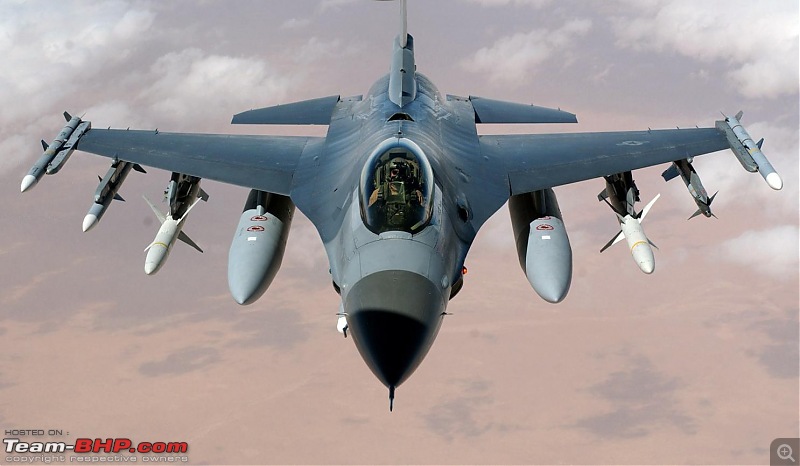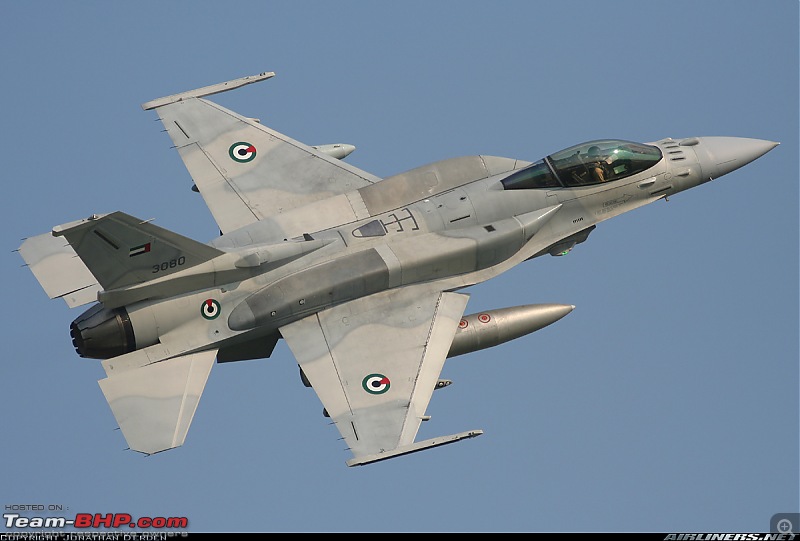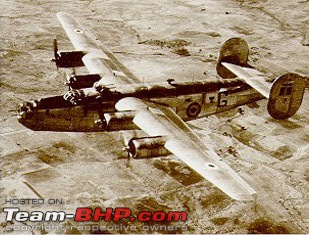| |||||||
| Search Forums |
| Advanced Search |
| Go to Page... |
 |
| Search this Thread |  1,185,245 views |
| | #376 | |
| Distinguished - BHPian  | Re: Combat Aircraft of the Indian Air Force Came across this news today. Personally, not so thrilled with this arm twisting. Quote:
| |
| |  (2)
Thanks (2)
Thanks
 |
| The following 2 BHPians Thank mpksuhas for this useful post: | SmartCat, V.Narayan |
| |
| | #377 | |
| Team-BHP Support  | Re: Combat Aircraft of the Indian Air Force Quote:
2) There is always some arm-twisting involved when dealing with US or Russia.  3) India has a large trade surplus with United States. Buying US defence machinery will shrink the surplus and probably keep Trump happy enough. Hopefully, he will not to fiddle with visas for Indian IT professionals. 4) F-16 has only one drawback and that is its combat radius. However, Block 70 that is being offered to India has conformal fuel tanks that enhances its combat radius by 40%. Normal F16:  F16 with CFT:  5) F-16 might be a light-weight fighter but its max payload (weapons and/or external fuel) is pretty decent at 7 tonnes 6) It might a 4th generation fighter but IAF doesn't need to have the latest, most expensive and shiniest toys. 7) Lockheed Martin is anyway procuring wings for all F16s from India https://www.cnbc.com/2018/09/04/lock...-in-india.html Only fly-in-the-ointment is that Pakistan has been operating F16s for decades now. Last edited by SmartCat : 22nd October 2018 at 00:07. | |
| |  (2)
Thanks (2)
Thanks
 |
| The following 2 BHPians Thank SmartCat for this useful post: | mpksuhas, V.Narayan |
| | #378 | |
| BHPian Join Date: Jul 2016 Location: Bangalore,Kochi
Posts: 157
Thanked: 434 Times
| Re: Combat Aircraft of the Indian Air Force Quote: But the LCA Mark 2.0 will be a different beast. So the whole idea of US is not to get LCA mark 2.0 out. Kill it before itís launch in 4 years time. If we buy F16/70 then LCA will face the same fate as Israel Lavi and probably forever kill Indian aerospace industry. | |
| |  (3)
Thanks (3)
Thanks
 |
| The following 3 BHPians Thank Czarcarsm for this useful post: | ksameer1234, mpksuhas, SmartCat |
| | #379 | |
| Distinguished - BHPian  | Re: Combat Aircraft of the Indian Air Force Quote:
Jeroen Last edited by navin : 9th January 2019 at 12:08. Reason: typo in quote | |
| |  ()
Thanks ()
Thanks
 |
| | #380 | ||
| Team-BHP Support  | Re: Combat Aircraft of the Indian Air Force Quote:
http://www.f-16.net/f-16-news-article781.html Quote:
 | ||
| |  (3)
Thanks (3)
Thanks
 |
| The following 3 BHPians Thank SmartCat for this useful post: | Jeroen, navin, V.Narayan |
| | #381 | |
| BHPian Join Date: Aug 2017 Location: Leeds
Posts: 937
Thanked: 2,259 Times
| Re: Combat Aircraft of the Indian Air Force Quote:
The Israeli's love a conformal fuel tank. They've been using them for years [see:https://foxtrotalpha.jalopnik.com/wh...ic-1712746714]. Much to Pierre Sprey's dismay I should imagine, the IAF fleet probably look like a bunch of gym junkies compared to the lithe original spec F-16. I don't think CFT's impact speed too much, in fact I'll wager they're slightly better in that regard than having a traditional drop tank. I'm not surprised the US is using the sanctions as a potential window to get F-16 orders in. I think arm twisting of this sort is pretty par for the course. But I had an interesting thought. If Lockheed indeed moves its entire F-16 production line to India, yes it might nix whatever slim prayers the Tejas has been coasting on. But let's say India, logically, insists on in country maintenance support. What say India insists that it should be the sole maintenance hub outside the states. The PAF would sure be in a pickle. Obviously they could still then only be left with the option to send their jets stateside for parts and repair with the potential they might end up stuck there if relations continue to wallow. I just thought having the rights to at least total parts manufacturing would be a pretty handy stick to have in a totally obtuse sense. I mean the PAF could then rationalise their decision to go all in on the JF-17 Thunder, which wouldn't come with the potential of being held hostage for parts..though that would be pretty ironic considering that it would mean we had given up on our own domestic hope..Still it's a handy thought experiment. I wonder if given the US focus on mid terms and the whole Khashoggi incident, if India might be more prudent low balling till after both those things blow over and then looking at how to avoid any sanctions in earnest or if now would be a good time to press our case given how distracted the White House will naturally be. | |
| |  (4)
Thanks (4)
Thanks
 |
| The following 4 BHPians Thank ads11 for this useful post: | navin, SmartCat, Stratosphere, V.Narayan |
| | #382 | |
| BHPian Join Date: Oct 2016 Location: Nearby
Posts: 70
Thanked: 75 Times
| Re: Combat Aircraft of the Indian Air Force Quote:
A great thought there. It was the first thing that came to my mind when I saw this news. I say, even if we lose the Tejas, we should take this deal and use the manufacturing competency we gain for the future AMCA. Weíll have resources to get the AMCA off the ground while also putting our primary adversary in a pickle.  | |
| |  ()
Thanks ()
Thanks
 |
| | #383 | |
| BHPian Join Date: Jul 2016 Location: Bangalore,Kochi
Posts: 157
Thanked: 434 Times
| Quote:
Drop tanks are dropped to improve performance, as you may know it already. I would think the General Dynamics saying conformal tanks have no performance impact needs to be taken with a pinch of salt. I remember reading how it reduced the agility in close combat. The original F16 is still the king in the F16 series. Pakistan has the newer block 52 as well, with more advanced electronics etc. Great thought on owing the full maintenance support as well. But the PAF F16 are very old and beaten to death. They may have very little airframe life left. The newer and lesser F16/block 52 may have more life. So not much strategic advantage there. But I guess overall it will be a great learning experience for the nascent Private sector aircraft manufacturers in India. That could be just what the doctor ordered. In fact we could change the flight control s/w on F16/block 70. It was done in the past. We had loaded our earlier LCA flight control s/w on an F16 before the sanctions hit ! The rumor is that F16 flew better with LCA control laws ! | |
| |  (1)
Thanks (1)
Thanks
 |
| The following BHPian Thanks Czarcarsm for this useful post: | SmartCat |
| | #384 |
| Distinguished - BHPian  Join Date: Aug 2014 Location: Delhi-NCR
Posts: 4,071
Thanked: 64,307 Times
| Re: Combat Aircraft of the Indian Air Force https://www.businesstoday.in/top-sto...ry/300943.html With the Supreme Court clearing the Rafale Deal I hope things will move ahead at least with the truncated 36 aircraft transaction and maybe one day with a larger number with local production/assembly.  Picture Source: Wikipedia Picture Source: Wikipedia |
| |  (1)
Thanks (1)
Thanks
 |
| The following BHPian Thanks V.Narayan for this useful post: | R2D2 |
| | #385 |
| BHPian Join Date: Dec 2010 Location: Pune
Posts: 78
Thanked: 147 Times
| Re: Combat Aircraft of the Indian Air Force Came across Team-BHP in a Hushkit article about the Indian Mig-25R fleet. https://hushkit.net/2018/12/12/lonel...-foxbat-pilot/ |
| |  (1)
Thanks (1)
Thanks
 |
| The following BHPian Thanks stewie for this useful post: | V.Narayan |
| | #386 | |
| Distinguished - BHPian  Join Date: Aug 2014 Location: Delhi-NCR
Posts: 4,071
Thanked: 64,307 Times
| Re: Combat Aircraft of the Indian Air Force Quote:
| |
| |  ()
Thanks ()
Thanks
 |
| |
| | #387 | |
| BHPian Join Date: Dec 2010 Location: Pune
Posts: 78
Thanked: 147 Times
| Re: Combat Aircraft of the Indian Air Force Quote:
 I probably should've posted it there in the first place! | |
| |  (1)
Thanks (1)
Thanks
 |
| The following BHPian Thanks stewie for this useful post: | V.Narayan |
| | #388 | |
| Senior - BHPian Join Date: Oct 2008 Location: kolkata/bangalore,india
Posts: 2,901
Thanked: 4,143 Times
| Re: Combat Aircraft of the Indian Air Force I came across this amazing story about how the B-24 Liberator bombers came about to be inducted in the IAF, and their history in the IAF. I was surprised to learn that IAF once flew these huge American bombers, and while looking for some more information found this. The Indian Air Force has such a long and rich history with so many different aircraft types fielded and the countless stories from the many wars it has been part of. I wish they were better known just like in other countries where a healthy circulation of aviation-related media and re-telling of war stories ensures that the bravery and ingenuity of the past is not forgotten. Original Link This story was uploaded on BharatRakhak.com, a well-known defense website/forum for the defense hobbyists. The other India Air Force aircraft histories on that website is worth going through! They are very rare first person or personal accounts and such information is hard to find on public domain. Quote:
Some photos from Google    | |
| |  (7)
Thanks (7)
Thanks
 |
| The following 7 BHPians Thank avishar for this useful post: | ads11, AirbusCapt, Alfresco, ninjatalli, Sutripta, Turbanator, V.Narayan |
| | #389 | |
| Distinguished - BHPian  Join Date: Aug 2014 Location: Delhi-NCR
Posts: 4,071
Thanked: 64,307 Times
| Re: Combat Aircraft of the Indian Air Force Quote:
The HAL of 1948 could rebuild what was then one of the 3 most complex bombers in the world. The HAL of today cannot get Su-30MKIs out on time. Sorry for the rant. In the 1965 Indo-Pak war a B-24 was sent off by the IAF to recce the sea around the Pakistani Makarran Coast with the hope of locating the enemy fleet. The Indian Navy was sailing towards Karachi with the expectation of a decisive engagement. The B-24's sole radio packed up and the aircraft opted to return back to base as without a radio there was no way of communicating its findings to the fleet 10,000 feet below. The IAF did not think about putting a replacement aircraft up there! It was later learnt that the two naval squadrons had passed by each other (although not within visual or surface radar range) in the night. The IN felt if the IAF had done a better job they could have engaged the Pak fleet. This incident eventually led to the long range maritime recce aircrafts being moved to the Navy finally in 1974 or 1975.  B-24 being gifted to the US Air Force by the IAF c.1968/1969 /Photo Source Late Group Capt Kapil Bhargava  B-24 in IAF service / Photo Source IAF | |
| |  (4)
Thanks (4)
Thanks
 |
| The following 4 BHPians Thank V.Narayan for this useful post: | ads11, Alfresco, avishar, Turbanator |
| | #390 | |
| BHPian | Re: Combat Aircraft of the Indian Air Force Quote:
Moreso ,when the aircraft built today by HAL has a mix of Russian and Israeli avionics . | |
| |  ()
Thanks ()
Thanks
 |
 |


